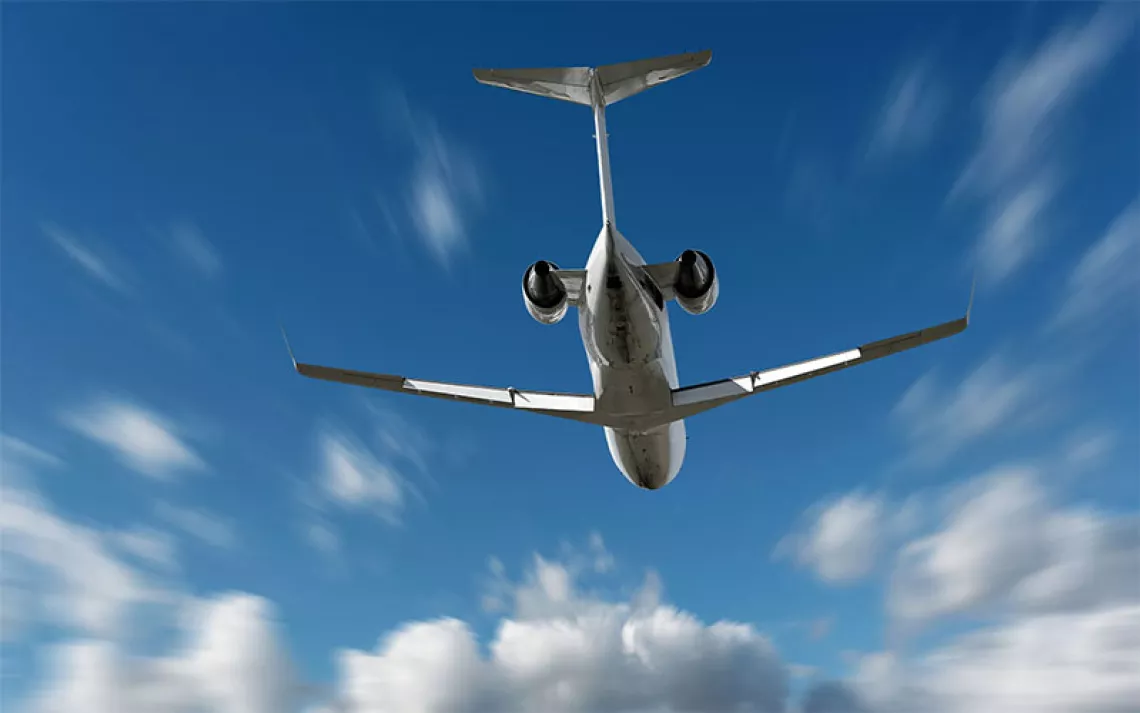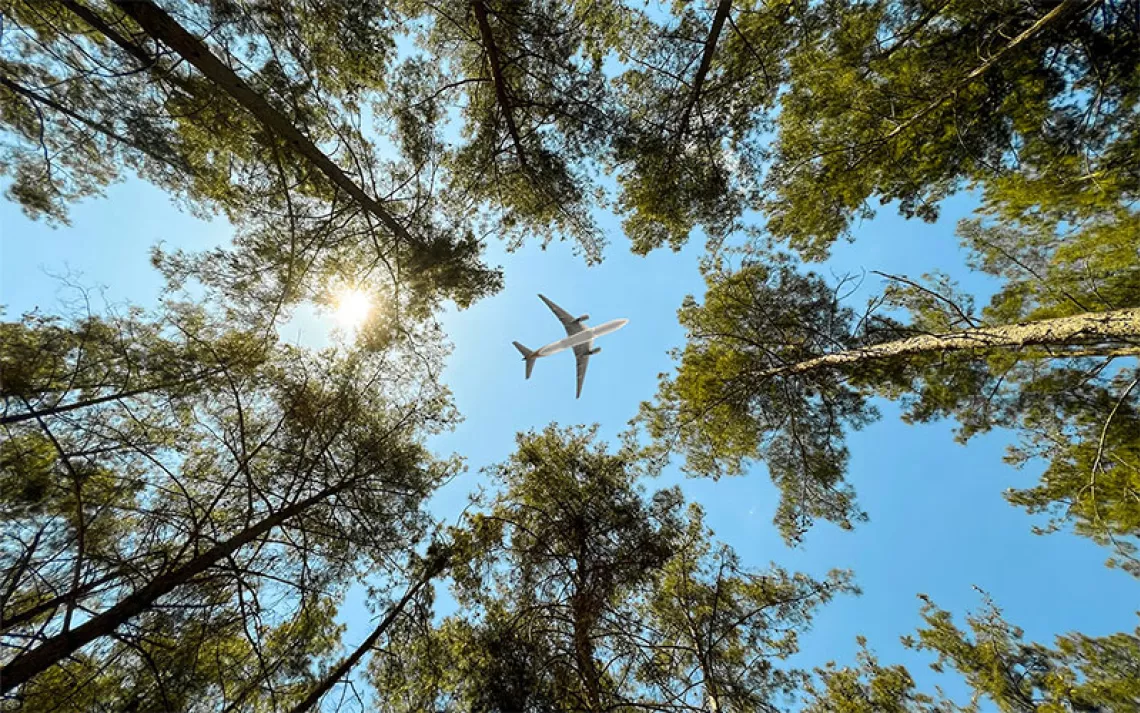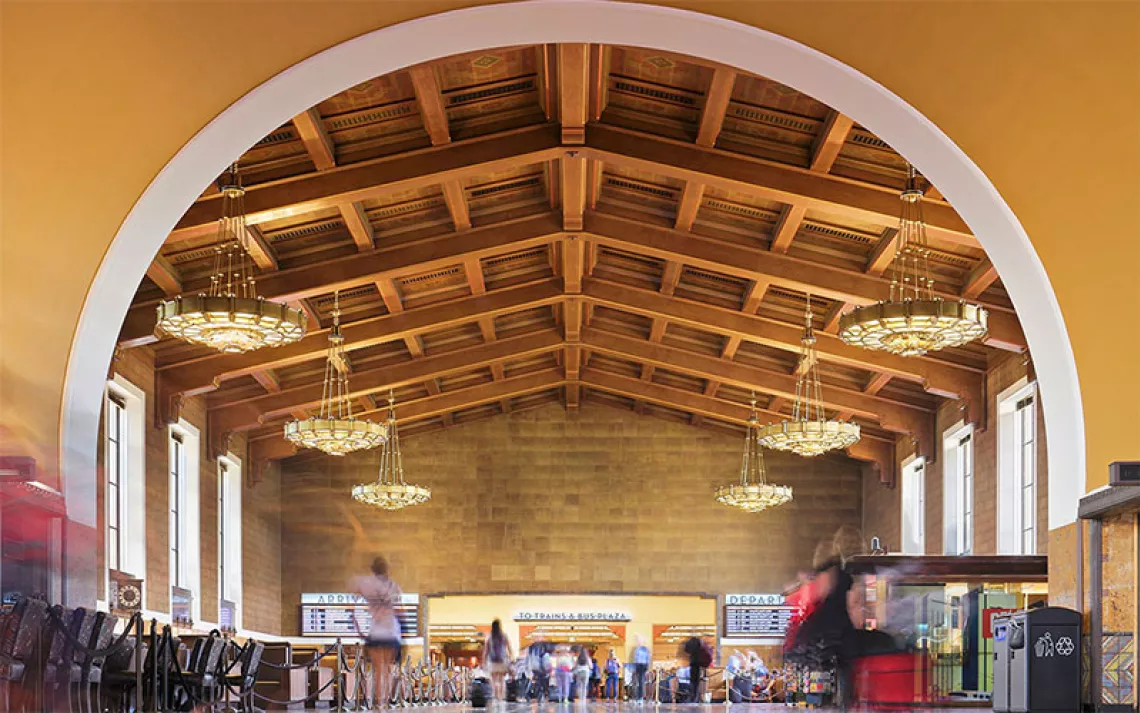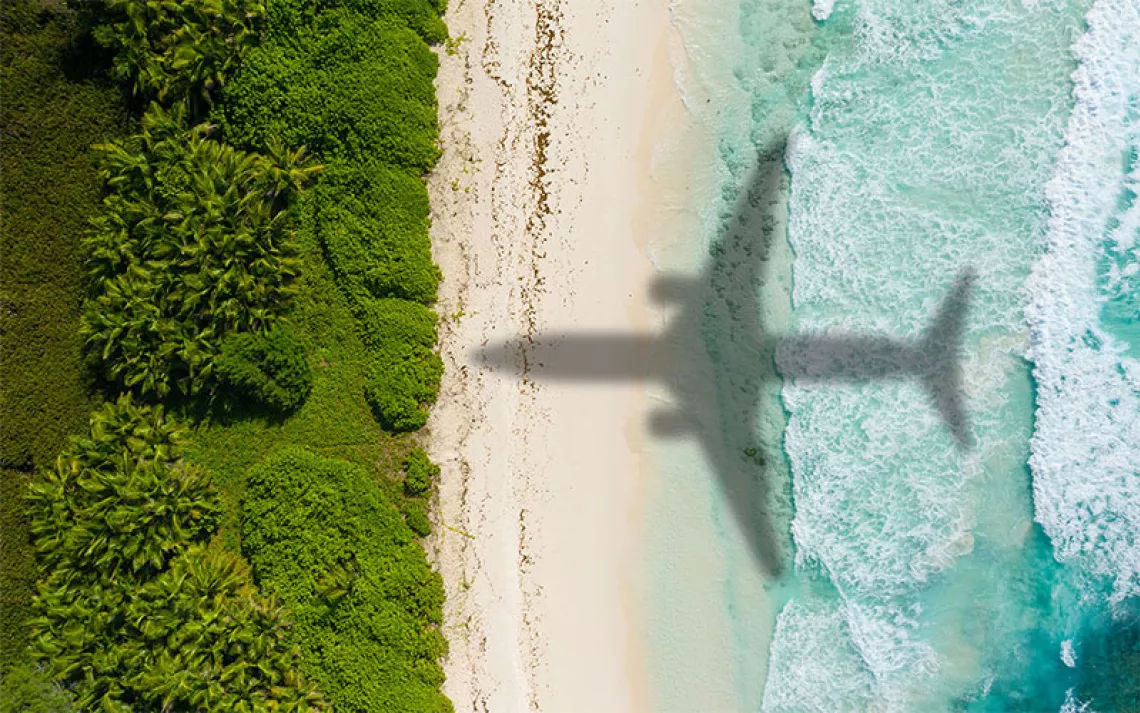The Carbon Footprint of Air Travel and How to Live a More Grounded Life
Is a future without air travel possible?

DAN CASTRIGANO'S LAST FLIGHT was on October 6, 2019. When the grade school teacher and climate activist realized that traveling by air made up 85 percent of his personal carbon footprint, he decided to never fly again. He submitted a pledge to Flight Free USA, an organization that encourages people to commit to flying less or not at all, and later became involved in running the campaign.
"I think a lot of people feel helpless [about the climate crisis]," Castrigano says. Choosing not to fly, he believes, is something they can do about it. He has found "great joy" in making lifestyle choices that align with his values and says that he feels "a sense of solidarity with other people who understand."
Those people are few and far between.
No other part of our lives illustrates the inequity of carbon emissions as starkly as air travel. The people with the biggest carbon footprint from air travel are, in global terms, a privileged minority. A disproportionate number of them are from the United States.
The United States emits more carbon dioxide from aviation than any other country, more than the emissions of the next 10 largest consumers of aviation fuel combined. If every human on the planet had flown as much as the average American in 2018, total CO2 emissions from passenger flights would have been five times larger. Less than 20 percent of the global population have been on an airplane; more than 80 percent of US residents have. And among those who travel in the United States, an affluent minority are the most frequent fliers. The 12 percent of Americans who fly six or more times annually are responsible for two-thirds of US passenger flights.
It's the wealthy frequent fliers who have the biggest carbon stamp from air travel—especially those jet-setting around on private craft.
It's the wealthy frequent fliers who have the biggest carbon stamp from air travel—especially those jet-setting around on private craft. The cultural footprints of such figures as Elon Musk, Taylor Swift, Jay-Z, Steven Spielberg, and Kim Kardashian are matched in size and scale by the carbon footprints their planes leave behind. One report estimated that in just over four hours of flight time, a private jet emits more CO2 than the average European does in a year. Consider then the revelation that between January and August 2022, Swift took 170 flights by private jet, racking up nearly 400 hours in the air. In 2022, Musk took 171 trips in his private jet, producing 2,112 metric tons of CO2. Business-class and first-class travelers also fare poorly: Their seats take up more space and are thus less efficient.

When it comes to reducing carbon pollution, there are bigger emitters to address. In 2018, aviation accounted for just 2.5 percent of worldwide carbon dioxide emissions. By comparison, passenger road vehicles emit nearly four times as much, and burning coal for energy accounts for almost 40 percent of global CO2 emissions.
Still, for many individuals, flying can represent a big chunk of their total climate footprint, and for people like Castrigano, that's reason enough to change their behavior. "Knowing what I know," he says, "I couldn't really get on a plane."
When we do have to fly, it doesn't need to have such a negative impact. Alternative fuels may eventually cut down on carbon emissions. The aircraft we take and the speed at which they move could make flying more energy efficient. Airlines could save big on emissions by simply getting us from point A to point B less quickly. According to Finlay Asher, a climate activist and former aerospace engineer for Rolls-Royce, planes could save significant fuel by going about 10 percent slower, but there is no incentive to do so. (Airlines make more money when they cram more flights into each day. And when travelers gripe about air travel, it's normally because they didn't get to their destination as fast as possible.) Planes could also be redesigned to save fuel. When Asher proposed this at Rolls-Royce, he was ignored. That was part of the reason he quit to found Safe Landing, an organization of current and former aviation workers pushing for major changes in the industry.
Asher proposes a simple formula for aviation's future: "Fly less frequently, less far, and less fast."
EASIER SAID THAN DONE. I first considered the environmental impact of flying during a 2014 college course on climate science and communications. My class was assigned an article by meteorologist Eric Holthaus titled "I Spent 28 Hours on a Bus. I Loved It." He had quit flying to reduce his carbon footprint and instead traveled to a conference on the mode of transportation with the lowest emissions: a bus.
Some in my class found Holthaus's flight-free pledge a bit extreme. After all, doesn't a 28-hour bus ride sound miserable?
But it resonated with me. I felt a responsibility to make different choices. I had gone vegan earlier in college. That same semester, I got involved in the fight against the Keystone XL tar sands pipeline. My own carbon footprint, however, was still high: Multiple times a year, I flew 3,000 miles from college in Princeton, New Jersey, to my hometown of Oak Park, California. That next summer, I would fly round trip to Kenya. I saw myself as an eco-activist, but my privilege and its footprint overshadowed my choices. Were my flights undoing other positive actions I was taking?
I often wondered: Am I doing enough for the climate? And can anyone take a guilt-free flight while the planet is teetering on the edge of the abyss?
Perhaps you've had similar crises of conscience over flying or driving, eating meat, or watering your lawn. Climate change is so personal, affecting how we travel, what we consume, how we power our homes. And yet it is also vast, making individual choices feel irrelevant, especially when no one seems to agree on which aspects of our lifestyles need to change and how much. I often wondered: Am I doing enough for the climate? And can anyone take a guilt-free flight while the planet is teetering on the edge of the abyss?
I started with simple changes: Direct flights are more efficient than flights with layovers because a lot of fuel is burned at takeoff and landing, so I switched to direct routes. Then I got more ambitious. After graduating, I took a 20-hour train ride from New York City to Chicago for an internship. On average, Amtrak travel is 34 percent more energy efficient per passenger than air travel, according to the US Department of Energy. When I moved to Berkeley, California, I regularly took an eight-hour bus trip from the Bay Area to my parents' house. A diesel bus emits about 70 percent less CO2 than a plane on a direct flight, making it the cleanest option outside of carpooling in an electric car.
Flights of 1,000 miles or more account for two-thirds of commercial aviation emissions; I had yet to replace most of mine.
My flying guilt trip came to a head when my first niece was born in September 2017, and I almost didn't journey home from Chicago to meet her. I had already flown three times that year, with two more trips scheduled in November and December. I was struggling to justify a sixth flight. A friend snapped me out of it—just do it and make it up to the planet later, he said. I decided I would fly home to meet my niece but replace a future flight with a 52-hour bus ride from Chicago to Los Angeles. A year later, I found myself on a roughly 2,000-mile overland journey.
I entered the rhythm of what I came to think of as "bus time": Far from big-city lights, it got dark early on the bus, and I would doze until morning. At sunrise, somewhere in the flat expanse of Missouri or Oklahoma, I took blurry photos of the red-orange light filling an endless sky. Away from my computer, the scenes around me came into a new kind of focus, from Midwest farms to the Arizona desert. Books were my entertainment. In two days, I finished Pacific Edge, a 1990 eco-utopian novel by Kim Stanley Robinson in which characters take trains and boats around the world rather than fly.
I can't pretend a Greyhound is utopia. A night spent nearly upright is unlikely to be the best sleep of your life. At every stop, the lights come on and the driver blares into the microphone, waking you up. And sometimes the buses kick you out in the middle of the night for cleaning or to switch drivers. On a subsequent bus trip, my Greyhound was set back more than 17 hours because of delays, adding a whole extra night to my journey.
Even Amtrak with its legroom and cafe cars is not always a joyride. On one journey, my train from Detroit to Chicago broke down and buses had to come rescue us. Unwilling to wait, people started calling Ubers down to the side of the tracks.
Those mishaps haven't dissuaded me from taking buses and trains all over the country, from New York to Los Angeles and from Portland, Oregon, to Detroit. In fact, I've grown to look forward to them. It's an escape from the hectic pace of day-to-day life—a chance to read a book, watch a movie, or just admire the view.
These trips are filled with moments that delight or surprise. For one stretch of California track, volunteers from the National Park Service came aboard to teach us about the area's history while we took in gorgeous ocean views. I've seen the sun set over the Columbia River, watched morning dawn in Glacier National Park, and marveled at the mountains and canyons of Colorado. I've met people I otherwise would not have: a self-identified hillbilly from the rural Midwest who foraged for his food and voted for Bernie Sanders; a North Dakota trucker who rides trains purely for fun and knows the attendants by name.
These trips have given me an up-close look at my country and its people that I could never have gotten from 35,000 feet.
Travel lets us experience new parts of the world and stay connected with family and friends. Anything that would make travel more difficult can feel like a burdensome sacrifice.
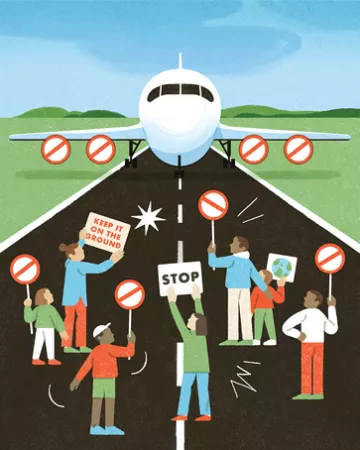
FOR MANY PEOPLE, dramatically reducing air travel feels out of reach. At its best, flying expands our horizons and brings us joy. Travel lets us experience new parts of the world and stay connected with family and friends. Anything that would make travel more difficult can feel like a burdensome sacrifice. But for a mix of fervent activists and dreamers, flying less isn't a burden: They have a vision of a different, better world, of fast, flashy trains and quiet electric buses; of less time at work and more leisurely vacations; of buying less stuff and shipping it more slowly; of shrinking militaries; of airports turned into hospitals, parks, and wildlife preserves. Some even envision a world in which airplanes become nearly obsolete.
If we improve and make alternative modes of transportation such as rail and bus more accessible, maybe we could translate the change we want into reality. In France, a grassroots citizens' assembly proposed a jet fuel tax as well as a moratorium on new airports and airport expansions. Both the French assembly and a Spanish one called for an end to domestic flights on routes that can be covered by a short train ride (which includes many of them). In the United Kingdom, a citizens' assembly supported a frequent-flier levy. Last summer, the Netherlands proposed that Amsterdam's Schiphol Airport—one of Europe's largest—limit its total flights in 2023 for environmental reasons, setting a cap at 15 percent below 2019 levels. Some of these examples are just efforts without outcomes, but activists sometimes do win: Castrigano helped lead a successful anti-expansion campaign against Vermont's Burlington International Airport.
"We need to change what's normal," says Ariella Granett, an architect and interior designer who used to travel by plane for work. In 2019, she watched with fascination as Swedish activist Greta Thunberg crossed the Atlantic Ocean in a solar-powered yacht to avoid flying to a meeting of the UN General Assembly in New York City. Granett switched to a more local job, cofounded Flight Free USA, and later helped start a campaign against the Oakland International Airport expansion. Flying, she now believes, should be kept "for dire necessities, emergencies, and lifesaving situations." We can learn to slow down for the rest of the time.
Planes do more harm than just spewing carbon pollution. About two-thirds of aviation's climate impact comes in the form of non-CO2 emissions. Contrails—the streams of white ice crystals planes leave in their wake—contribute to global warming, along with nitrous oxide and other gases released at high altitudes. Aviation causes old-fashioned air pollution too. Planes emit ultrafine particles linked to lung, heart, and blood pressure problems and risks to fetal growth. Noise pollution from aircraft may also increase the risk of high blood pressure and strokes, in addition to being an annoyance. In April, residents near the Seattle-Tacoma International Airport filed a class action lawsuit against two airlines, claiming that jet pollution is making them sick.
Of aviation's CO2 emissions, 71 percent come from commercial passenger travel, demand for which is growing at breakneck speed. The total passenger miles flown is predicted to triple between 2018 and 2050. (The remaining aviation emissions come from a mix of freight, military, and private flights.)
Airlines have made little progress in reducing their climate impacts. The International Air Transport Association has repeatedly failed to meet its own climate goals. In October 2022, the UN's International Civil Aviation Organization made its first-ever commitment to reach net-zero emissions by 2050. Like many of the glitzy but anemic net-zero commitments bandied about by banks and oil companies, the UN agreement is nonbinding.
Climate advocacy groups have proposed an end to frequent-flier programs that incentivize flying and have called for an increasing tax for each additional flight—a frequent-flier levy. Sola Zheng of the International Council on Clean Transportation (ICCT) recently modeled a global levy and found that it could reduce demand by 7 percent while mostly affecting the wealthiest fliers. The rich have to pay up, but "it doesn't really stop a person from flying once a year to see their family," she told me.
If every American flew just once each year, that would cut the country's aviation emissions by more than half. It's of course harder for the typical American to fly less than for someone in Japan or Germany. We are far more spread out, and those countries have excellent rail systems. But rather than prioritize alternatives, the United States is expanding airport infrastructure. Activists are currently fighting expansions across the United States, including in Seattle.
What about switching to lower-emission fuels? The Inflation Reduction Act provides a tax credit for sustainable aviation fuels (SAFs), and government bodies such as the Department of Defense are investing in them. Today, SAFs are typically biofuels made from animal fats, used cooking oil, and other vegetable oils, although feedstocks such as forest residues, crop residues like cornstalks, and captured methane from landfills are also being developed. The most readily available sources are limited, and others have significant cost and sustainability issues.
In 2021, the Biden administration announced the SAF Grand Challenge, a plan to power aviation entirely with 35 billion gallons of biofuels. Advocacy groups are working to ensure that this plan, and the provisions in the Inflation Reduction Act to accelerate SAF production, do not incentivize the widespread use of fuels made from food crops like corn and soy. That would be a disaster. Crop-based fuels divert land that would otherwise be used to grow food we eat, destroying wildlife habitat in the process. Making the 35 billion gallons of biofuel from corn would require an area around the size of New Mexico; soy would take even more space. A 2022 study funded in part by the Department of Energy found that corn-based ethanol is overall worse for the climate than gasoline.
The ICCT says that synthetic fuels, or e-fuels, could play a larger role. E-fuels are made from hydrogen and captured carbon dioxide and can dramatically reduce the climate impact if those two ingredients are sourced cleanly. But the process requires massive amounts of electricity. The ICCT estimates that aviation in 2050 might require the electricity equivalent of all the renewable power available today. According to the advocacy group European Federation for Transport and Environment, powering all of Europe's aviation with e-fuels would need so much solar and wind electricity that the generation facilities could cover an area equivalent to Greece and Belgium combined.
Safe Landing's Asher thinks that hydrogen, not SAFs, will eventually power planes—and that would require a wholesale redesign of aircraft. Battery-powered electricity would be the cleanest option, but the technology is still young. Large batteries are heavy and may never work for longer flights.
So while it would be wonderful to make air travel guilt- and emissions-free, the technology is nowhere near where it needs to be. Making aviation carbon neutral anytime soon is a pipe dream.
We just need to give people more and better options so they can make that choice.
THE BEST WAY to reduce your carbon footprint from air travel? It's simple: Choose not to fly.
We just need to give people more and better options so they can make that choice. "If flights are the only possible means to get around, it's unfair to blame individuals, even though individual actions can shape societal norms," says Mira Kapfinger of Stay Grounded, a global network with the goal of reducing aviation. She says we must "change structures and possibilities," including providing more reliable, affordable ground options such as bus and rail for those willing to travel more slowly. The technology and the rail lines are all there. What's missing is financial support and political will.
Greyhound, for example, is often racked by delays due to a lack of drivers. Government intervention could help by offering subsidies or creating a federal jobs program to provide a larger pool of well-paid drivers and ensure that tickets are consistently affordable.
Historically, subsidies for Amtrak, which is government-owned, have been paltry compared with those for highway and air transportation. Amtrak's 2023 federal budget was only 29 percent of the Federal Aviation Administration's budget. With more investment, Amtrak could lower its ticket prices and thus become more competitive with air travel. Long-distance Amtrak trips can be more expensive than flying on a budget airline like Spirit—though at least luggage and carry-on bags are included in Amtrak prices.
Amtrak is also bogged down by delays, largely because in most states the freight companies own the rail lines. Freight rail has unpredictable schedules, and passenger trains are subject to its whims, forced to stop and wait whenever a freight train needs the rails. Until passenger travel is prioritized, says Madison Ned Butler of the Rail Passengers Association, "we aren't going to get to where other countries are. When [freight companies] make the Amtrak late, they should be paying fines for that." Expanding routes is also key: Many parts of the country have no Amtrak line connecting them, even where freight lines exist.
Amtrak, Butler argues, should be treated as a public service like a fire department or a library because of the associated public benefits, offering a low-carbon travel option and accessibility for those who can't drive. From a climate perspective, Amtrak outperforms planes, but not by as much as it could. Outside the Northeast, Amtrak still runs on diesel, and while taking Amtrak is far less polluting than flying for short trips, for longer trips of over 1,000 miles or so, direct flights release slightly less CO2 per person. That's because trains burn more fuel for their frequent stops and starts and contain more empty seats.
We know how to bring train emissions down: In the Northeast and across much of the rest of the world, trains are electrified, powered by overhead lines. Electrifying US rails would be an expensive undertaking but result in tremendous efficiency—with a rail journey requiring roughly one-tenth the energy of a flight the same distance, according to the International Energy Agency.
Two nights in a recliner chair, I admit, takes some getting used to. What if a train could get cross-country in a day?
"High-speed rail is so fast and it's so high-capacity that it literally transforms entire regions," says Andy Kunz, president and CEO of the US High Speed Rail Association. Longer journeys at speeds of 200 miles per hour or faster would revolutionize how we travel—the two-day Amtrak ride from Los Angeles to Chicago might take only 12 hours.
There is, of course, no high-speed-rail system in the United States. The Build Back Better bill included $10 billion to finally make high-speed rail a reality. Then Senator Joe Manchin gutted it. Rick Harnish, executive director of the High Speed Rail Alliance, says we need a dedicated line item for high-speed rail in the federal budget each year and a nationwide plan for an integrated rail system.
Instead, we have the 2021 Bipartisan Infrastructure Law, which included $66 billion for intercity rail, some of it earmarked for Amtrak. The California High-Speed Rail project will apply for money from this pool to finance its tortured San Francisco–Los Angeles route. That initiative is a decade behind schedule, with a $128 billion budget, almost quadrupling initial projections. But it's the first such line we've attempted, Kunz says. The project has seen modest progress in over 119 miles of construction, and under new leadership, it has secured more funding and cleared more environmental reviews. Meanwhile, a private company called Brightline West will break ground this year on tracks for a bullet train from Los Angeles to Las Vegas (one of the country's most popular flight routes) that can reach 180 miles per hour. At that rate, weekend revelers could make the trip across the desert in just over two hours.
High-speed-rail advocates point to China as an example of what's possible. In 25 years, China built a 26,000-mile high-speed-rail network that serves a billion and a half riders annually and hopes to nearly double that by 2035. The Jinghu high-speed railway takes passengers from Beijing to Shanghai—an 800-mile trip—in just over four hours, making it the fastest passenger train in the world.
Without a transformation of the US transportation system, Kunz says, "planes will still be flying and polluting like hell . . . , [and] the highways will still be overloaded. Unless we really go big in high-speed rail, I don't see how we're ever going to solve any of this mess."
"Slow travel" is sometimes marketed as a new, more immersive way to see the world. Really, it's the old way come back.
LOREAL PALMER HAS TRAIN down to a science. A full suitcase of snacks. A tangle of chargers for phones, tablets, laptops, Kindles. Movies downloaded for each of the kids, ages four, six, and eight. When I met her last August, she was taking her family on a 43-hour Amtrak ride from Chicago to Los Angeles, and it clearly wasn't her first one: "I'm a professional now," she told me.
For Palmer, travel hasn't always been this smooth. More than a decade ago, she explained, she was on a plane that "almost went down." Since then, flying has terrified her, and she has been doing most of her travel by train. She has also learned more about aviation's environmental effects, further motivating her decision not to fly. While friends tease her, she's determined to show that you don't need planes to see the world. Her family will be flying to Europe next spring, and she plans to take a weeklong journey by cargo ship to meet them there. "I don't want to be a hypocrite," she said, "so I'm going for it."
I've met a lot of people like Palmer, who are leaning into slower travel because of bad flight experiences or simply because they enjoy the views. "Slow travel" is sometimes marketed as a new, more immersive way to see the world. Really, it's the old way come back.
Part of why two-day journeys feel so long is the frenetic pace of our contemporary lives. We feel like we always have to be connected. We always have to get back to work. The United States is one of the few countries without guaranteed paid vacation days. In the European Union, four weeks are guaranteed, with some countries offering even more. The UK organization Possible is encouraging businesses to offer "climate perks" like increased vacation time for those who choose to take the train or bus rather than fly. If we want people to have time for slow travel, then paid vacation time is essential—and it would improve our lives in other ways as well.
With longer vacations and more flexible work locations, travel could become as much about the journey as about the destination. We could make it easier for people to get off a train or bus to get a good night's sleep and perhaps explore a new city, then hop back on the next day. This would require changing how trains are scheduled and require financial incentives to make it viable. For instance, the government could offer vouchers for a free bed-and-breakfast to people who take train or bus trips. With high-speed rail years away and zero-emission flights even further, it's a shift in culture—from social norms to vacation policies—that can help get people out of planes. It would probably be a lot more fun to travel this way too.
Imagine a world in which traveling long distances no longer involves that trip to the airport two or three hours early followed by queuing up in long, stuffy security lines, or the indignity of having to pay extra for luggage. Imagine, instead, an integrated system of buses, standard trains, and high-speed rail, all electric powered, letting you take a deep breath and take in the scenery—letting you finally slow down. What experiences might you have that you otherwise wouldn't? In 2040, perhaps, if I travel from Detroit to Los Angeles, I might take a high-speed line to Chicago and transfer to a normal-speed Amtrak to Denver. Then I'd stop and hike in the Rockies for a day or two, take an electric bus to Las Vegas, and finally get on a high-speed train to Los Angeles—all on one or two tickets. Sure, someone or something might be waiting for me in LA—but it can wait.
All of this amounts to a social transformation in how we think about travel—in the very rhythm of our work and leisure lives. As we make our societies greener and more humane, we may find that the 120-year technology of the aeroplane is no longer best suited for the world we are trying to build. Do we really want more mines and more habitat destruction to power e-fuels and hydrogen? Is demarcating huge swaths of land for concrete-and-asphalt airports really the most creative use of our cities? Do we really want to be in such a hurry all the time?
"Humans have been flying for over 100 years," Castrigano observes, but "we've been around for 200,000."
We are due for new ideas about what it means to live well. Perhaps by the end of this century, people will look back in bewilderment that we ever thought it essential to move around so fast—and that we ever thought we belonged so far above Earth.
How can we move from flying shame to flying solutions? Sierra Club board member Ross Macfarlane shares his point of view: sc.org/flying.
 The Magazine of The Sierra Club
The Magazine of The Sierra Club
